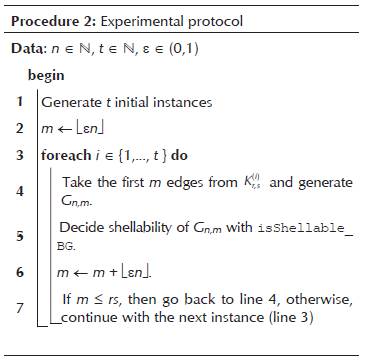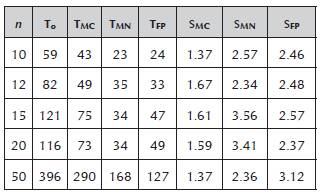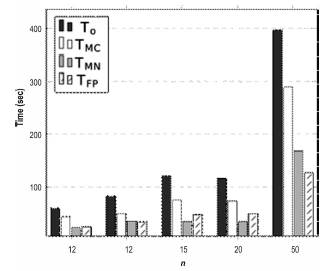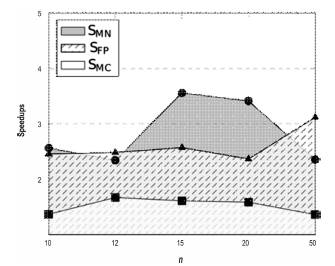Introduction
Simplicial complexes are combinatorial structures frequently used in geometrical applications because of their flexibility for modeling objects from different spatial dimensions. The presence of one of their combinatorial properties, known as shellability, has proved to be useful in practical situations (see, for example the works of Herlihy (2010) and Müller-Hannemann (2001)). The concept also appears in graph theory where, through the Stanley-Reisner correspondence, a simplicial complex may be associated to a graph (Van Tuyl & Villarreal, 2008).
Simplicial complex shellability and its graph counterpart have been well-studied and widely used in diverse mathematical and practical issues, but there exists relatively little work about their computational complexity. Although deciding shellablility requires significant amounts of computational time, it is currently unknown if the problem is either in P or in NPC (i.e. NP-complete) (Kaibel y Pfetsch, 2003).
In order to understand the computational behavior of graph shellability, and based on some combinatorial characterizations, the problem is commonly tackled by analyzing particular graph families. Fortunately, in the case of bipartite graphs a complete characterization was made in (Van Tuyl y Villarreal, 2008) and (Cruz y Estrada, 2008) that was further used in (Santamaria-Galvis, 2013) to propose a bipartite graph shellability solver called isShellable_BG.
isShellable_BG decides bipartite graph shellability in exponential time and was used in a sequentially designed experiment as a tool for collect some data that could be used in further research to construct some conjectures about the problem’s behavior.
In this paper, with the aim of improving the performance of the sequential experiments performed in (SantamariaGalvis, 2013), we propose and implement three parallel alternatives using Apache Spark™ (Spark™, 2016).
Methods and Materials
Main Notions and Required Results
A (simple and finite) graph G is a tuple of two finite sets (V,E) where V is the set of vertices and E is a set of unordered pairs over V called the edges of G; no edge is repeated and loops, i.e. edges from one vertex to itself, are not allowed. Two vertices x1,x2∈V are said to be adjacent in G if (x 1 ,x 2 )∈E. A subset F of V is an independent set of G if not two vertices of F are adjacent in G; F is a maximal independent set if it is not properly included inside another independent set. If x is a vertex of V, we denote by N(x) the open neighborhood of x, i.e., the set of all vertices adjacent to x, N[x]: ={x} ∪ N(x) the closed neighborhood of x, and deg(x) :=|N(x)| the degree of x. A vertex with degree 1 is called a pendant vertex. A graph G is bipartite if its set of n vertices can be partitioned in two sets V α and V b such that no edge exists in vertices of the same set. Figure 1 (left) represents a bipartite graph. We say that a bipartite graph is complete if every vertex in V b is adjacent with every vertex in V b . We denote it by K r,s , where r = |V α |, s = |V b |.
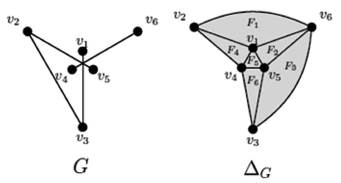
Figure 1 A bipartite graph G and its associated (pure) simplicial complex ΔG. The ordering F 1 , F 2 , F 3 , F 4 , F 5 , F 6 is a shelling of ΔG; consequently, ΔG is a shellable simplicial complex and G is a shellable graph.
A (n abstract) simplicial complex Δ over a set of vertices V is a finite and nonempty collection of subsets of V called faces, such that if A is a face of Δ, then so is every nonempty subset of A. Figure 1 (right) shows a graphical representation of a simplicial complex. The dimension of a face A is defined as dim(A) := |A| -1 and the simplicial complex dimension is defined as dim(Δ) := max(dim(A)). The maximal faces in Δ are called facets. If every facet in Δ has dimension d, is d-dimensional and is called pure. For sets A ⊆ B, there exists the boolean interval [A; B]: = {C| A ⊆ C ⊆B}. Let A: = [Ø; A]. A complex of the form A is called simplex (Björner y Wachs, 1996), (Schläfli, 1901).
We can define shellable simplicial complex and its related decision problem as follows.
Definition 1 (Shellable simplicial complex (Björner y Wachs, 1996)). A simplicial complex is called shellable if its facets can be arranged in a linear order F
1
,F
2
,…,F
t
, in such a way that the subcomplex  is pure and (dim(F_k) 1)-dimensional for all k=2,…,t. Such an ordering of facets is called a shelling.
is pure and (dim(F_k) 1)-dimensional for all k=2,…,t. Such an ordering of facets is called a shelling.
It is easy to show that SCS is a decision problem in NP, but it is currently unknown whether it is in P, NPC or even fits in another class into NP (Kaibel, y Pfetsh, 2003). With the aim of understanding the complexity of SCS we could deal with a related problem. The next definition introduces a kind of simplicial complex which could be generated from a given graph. Thus, SCS could be partially studied through some graph families where shellability is fully characterized, e.g. there are complete characterizations for the property on chordal, bipartite, arc-circular, vertex decomposable, simplicial and recursively simplicial graphs in (Van Tuyl y Villarreal, 2008), (Cruz y Estrada, 2008), (Woodroofe, 2009) and (Castrillón y Cruz, 2012).
Definition 2 (Independence (simplicial) complex of a graph (Van Tuyl y Villarreal, 2008)). Let G = (V,E) be a graph on the vertex set V = {x1,…,x n }. By identifying vertex x i with the variable x i in the polynomial ring R= k[x 1 ,…,x n ] over a field k, we can associate G with a quadratic square-free monomial ideal I(G) = ({x i x j | (x i ,x j )∈E}) where E is the edge set of G, the ideal I(G) is called the edge ideal of G. By using the Stanley-Reisner correspondence, we can also associate G with the simplicial complex ΔG, called the independence (simplicial) complex of the graph G, where IΔG = I(G). Thus, the faces of ΔG are the independent sets of G.
Now, we can define shellable graph and graph shellability as a decision problem.
Definition 3 (Shellable graph (Van Tuyl & Villarreal, 2008)). Let G be a graph and ΔG its independence complex. G is shellable if ΔG is a shellable simplicial complex.
It is also unknown whether GS is either in P or in NPC, and that is also the case for bipartite graphs; however, as we shall show in detail, the next theorem is useful to decide GS for bipartite graphs.
Theorem 4 (Van Tuyl y Villarreal, 2008), (Cruz y Estra-da, 2008). Let G be a bipartite graph. Then G is shellable if and only if there are adjacent vertices x and y where x is a pendant vertex such that the graphs G \ N G [x] and G\N G [y] are shellable.
Notation: From now on, and for the sake of brevity, we shall use GSbipartite when we refer to GS for bipartite graphs.
isShellable_BG: A solver for GSbipartite
Let G be a bipartite graph on the vertex set V with n:=|V| and St(G) be the set of the maximal independent sets of G. A direct interpretation of the theorem 4 leads to the exponential time algorithm isShellable_BG (Procedure 1), which was proposed by (Santamaria-Galvis, 2013) as a tool to analyze the computational behavior of GSbipartite It was implemented in C/C++ using the igraph library (Csárdi y Nepusz, bipartite graph K r,s , r + s = n with its rs edges randomly stored in a file; besides, r and s are also randomly chosen from the given n. Every initial instance was used to generate a set of actual instances. Let K(i) denote the i-th initial instance and G n,m an (actual) instance of GSbipartite with n vertices and m edges. Once t and ε ϵ (0,1) are fixed, an experiment could be performed for several values of n by using the next experimental protocol: 2016). This is a faster alternative than calculate GS directly, i.e. by first obtaining all the maximal independent sets of G. Note that the mere problem of finding the maximum independent set in G is an NP-hard problem for the general case. Fortunately, isShellable_BG offers a way to solve GSbipartite directly from G by avoiding the heavy precalculations required to construct St(G).
To understand the asymptomatic behavior of GSbipartite over increasing values of n and to build some conjectures, a sequentially designed experiment was also implemented by (Santamaria-Galvis, 2013) using isShellable_BG. The next section explains the protocol over which the experiment was performed and how we built our proposal.
Statistical analysis
Before describing our proposal, it is necessary to properly introduce the original experimental protocol in such a way that we can describe our three approaches.
Original experimental protocol
For several values of n, a set of t initial instances was created for each n. Each initial instance is a complete bipartite graph Kr,s, r + s = n with its rs edges randomly stored in a file; besides, r and s are also randomly chosen from the given n. Every initial instance was used to generate a set of actual instances. Let  denote the i-th initial instance and Gn,m an (actual) instance of GSbipartite with n vertices and m edges. Once t and ε ϵ (0,1) are fixed, an experiment could be performed for several values of n by using the next experimental protocol:
denote the i-th initial instance and Gn,m an (actual) instance of GSbipartite with n vertices and m edges. Once t and ε ϵ (0,1) are fixed, an experiment could be performed for several values of n by using the next experimental protocol:
Thus, a sequentially designed experiment was performed in (Santamaria-Galvis, 2013) after setting the values ε = 0.1, t = 200, and n = 50,100,150 over the previous protocol. Here, the word sequential is employed to mean that in the whole experiment just a single computer (node) was used and, inside it, only one core; the other cores remained idle. Because of the low values of n that could be tested there, no conclusive results were obtained regarding the asymptotic behavior of GSbipartite.
In this work, under the assumption that parallelization could relieve to some extent the computational burden involved in the original sequentially performed experiment, we propose three parallel ways of running the aforementioned experiment by slightly modifying some steps in the protocol. Here, it is important to stress that our parallel approaches are intended for the experiments themselves, not for the exponential time routine isShellable_BG.
Our proposal
To achieve parallelization over the experimentation, we propose three options by using Apache Spark™ (Spark™, 2016) as a framework for cluster computing and Apache™ Hadoop® (Hadoop®, 2016.) as underlying distributed file system. We call them multicore approach, multi-node approach and full-parallel approach. They are completely defined by the modifications they impose over the protocol of Procedure 2. In this description, we intentionally omit those accessory details we consider strictly operative:
After line 1, the whole set of actual instances is generated from the initial ones. They are stored in Hadoop.
Depending on the approach, Spark runs line 5 originally intended to be run under a sequential schemein one of these ways: (i) In the multi-core approach, Spark uses just one node during all the experimentation, but each core inside is always busy running isShellable_BG over a different instance. Although the cores are independently used, the other resources (main memory, cache, etc.) are shared. (ii) In the multi-node approach, Spark uses several nodes: one node as master and several nodes as slaves. Every slave can decide GS_bipartite by using its resources, but just one core per node is actually used. (iii) The full-parallel approach, proceeds as the previous one, but with two cores per node.
Performance Test
Let us fix the values ε = 0.1 and t = 200. Then, to contrast the efficiency of our proposal, we proceed as follows:
For every value of n in {10,12,15,20,50}, a set of initial instances was created; after that, the set of actual instances was generated and stored in Hadoop in order to be evaluated by the solver afterwards. For increasing values of n, the sets of instances were run over the three approaches in this way: (i) The protocol from Procedure 2 was run as is since line 3 to line 7. The total time T o (n) (in seconds) that it took to accomplish the whole task (i.e., to solve the problem for every instance in the given n), was stored and used as reference. Note that this is, in fact, the original approach. (ii) In an analogous way, we run the modified protocols for the multi-core, multinode and full-parallel approaches over the same lines and we store the respective total times T MC (n), T MN (n) and T FP (n) (in seconds). The multi-node and full-parallel approaches used one master and two slaves; besides, the same master is also used as the single node for the multi-core approach. The master node has 4 cores and 57GB of RAM, and the slave nodes have 2 cores and 15GB of RAM.
Once the experiments were finished, we had to choose an appropriate measurement for their relative efficiency. Thus, in the sense of (Hennessy, y Patterson, 2012), we opted for the speedups of the enhanced experiments. The speedup of some computational task reflects an improvement in speed of its execution and consequently means an improvement in its efficiency. The speedup could be properly defined as the ratio between the execution time for a task without using the enhancement and the execution time forT the samTe task using it. Thereby, we could define  and
and  as the speedups for the multi-core, multi-node and full-parallel approaches, respectively. In this way, every speedup reflects how fast a routine is regarding some fixed reference.
as the speedups for the multi-core, multi-node and full-parallel approaches, respectively. In this way, every speedup reflects how fast a routine is regarding some fixed reference.
FP 0 as the speedups for the multi-core, multi-node FP and full-parallel approaches, respectively. In this way, every speedup reflects how fast a routine is regarding some fixed reference.
Results
After setting the parameters, we run the aforementioned performance test, and then, we tabulated the results. Table 1 displays the execution time alongside the speedups of our proposal, both over increasing values of n. Time is rounded to the nearest second in each case, and speedups are rounded to two decimal places.
Total execution time T 0 , T MC , T MN , T FP , (in seconds) for the original, multi-core, multi-node and full-parallel approaches, respectively. S MC , S MN , and S FP for the multi-core, multi-node and full-parallel speedups, respectively
In order to evince the improvements, we plotted two graphics: Figure 2 contrasts the performance of every approach as function of n. Figure 3 compares the three speedups, also, as function of n.
The results suggest increasing efficiency regarding the original protocol design. The speedups fluctuate between 1.37 and 1.67 for the multi-core approach, between 2.34 and 3.56 for the multi-node, and between 2.37 and 3.12 for the full-parallel. This behavior can be observed in Figure 2 where time usually reduces from one approach to another, and in Figure 3 where the speedups for the multi-core approach are always under the multi-node and full-parallel approaches. Maybe, the use of several machines with independent resources for the multi-node approach played the differential factor in the performance.
Discussion
This work was intended for verifying whether one of the enhanced approaches could be used instead of the original one. A first conclusion we can draw is that the computational burden of the sequential protocol could be effectively relieved by using the parallel techniques we consider here. The times and speedups in Table 1 confirm it. However, we can distinguish different levels of improvement.
Figure 2 suggests that, for increasing values of n, the multi-core approach is outperformed by the others. Regarding them, we can see that multi-node and full-parallel approaches are almost in a draw for n < 20, then, for n = 20, the full-parallel approach is less efficient than the multi-node one, but the performance swaps when n =50. Those differences are reinforced in Figure 3 but in terms of speedups, which range between 2.34 and 3.56 for the multi-node approach, and between 2.46 and 3.12 for the full-parallel one. Nevertheless, it could be hazardous to generalize a concrete behavior, mainly because the test was performed for relatively small values of n. Nevertheless, we could conjecture that for increasing values of n the difference between the approaches will stabilize. We suspect that the more parallel elements (nodes and cores) the approach includes, the less time is required to complete the whole experiment. Thus, the full-parallel approach looks like the best candidate to deal with higher values of n.
As a future work, a new version should try the new library GraphX of Apache Spark™ in order to deal directly with some graph related functionalities. The use of GraphX could be better than our approach because the library seems to coexist in the same architectural level of the framework.
On the other hand, and in a more general sense, we suggest this parallel scope to deal with similar combinatorial problems where experimentation over massive sets of data is required either to construct mathematical conjectures or to analyze their asymptotic behavior.
















